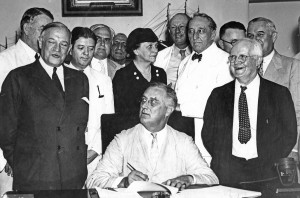
Signing the Social Security Act, 1935
FDR signs the Social Security Act with Labor Secretary Frances Perkins, the first woman to serve in the Cabinet.
On August 14, 1935, President Franklin Roosevelt signed the Social Security Act, declaring: “If the Senate and the House of Representatives … had done nothing more than pass this Bill, the session would be regarded as historic for all time.” Nonetheless, Roosevelt acknowledged that the groundbreaking legislation was “a cornerstone in a structure … by no means complete.”
Once the cornerstone was laid, Social Security soon expanded. Initially, its two social insurance programs, Old Age Insurance and Unemployment Insurance, covered only a portion of the work force. Left out were workers in very small establishments and the public sector, along with the self-employed. Also excluded were domestic workers—largely women and agricultural workers—occupations in which many African Americans were employed.
Within four years Social Security extended benefits to widows and orphans. In 1950, Congress added coverage for domestic and agricultural laborers. Disability insurance was also added in the fifties, and Medicare in the mid-1960s. In 1972, automatic cost-of-living increases began. Unemployment Insurance has been less expandable, but groups previously excluded became covered in 1970 when Congress also provided for automatic extensions of benefits during recessions when many workers are laid off.
Headed by FDR’s Labor Secretary Frances Perkins, the Committee on Economic Security, which proposed the Social Security Act, recognized that “employment assurance” was the key to economic security. The committee acknowledged that public-work programs might be necessary not only during periods of economic depression, but during normal times as well. Roosevelt and Federal Relief Administrator Harry Hopkins considered creating a permanent government employment program for those still jobless after receiving short-term unemployment compensation.
Ultimately, the government settled on permanent, short-term Unemployment Insurance as part of the Social Security Act, and a temporary employment program—the Works Progress Administration (WPA), which hired millions of people and vastly enriched the country’s physical, social, and cultural resources. The WPA was terminated during World War II when job creation became temporarily unnecessary. Thus, Perkins wrote in the mid-1940s, “Unemployment Insurance stands alone as the only protection for people out of work.”
What might Roosevelt, Hopkins, and Perkins have said when, in the aftermath of the Great Recession of 2008, many jobless workers collected extended unemployment benefits instead of getting paid to restore the country’s decaying infrastructure, making our economy and planet more sustainable, and providing sorely needed social services?

Ida May Fuller, 1940
Ida May Fuller was the first to receive a monthly Social Security check. She received $22.54.
Nearly seven years after the Great Recession 20 million people remain jobless or are forced to work part time. The proportion of working-age people working or actively looking for work is the lowest since 1976.
Federal legislation pending in Congress comes close to completing the Social Security edifice begun 80 years ago. The Humphrey-Hawkins 21st Century Full Employment & Training Act, https://conyers.house.gov/index.cfm/jobs introduced by Rep. John Conyers, Jr. (D-MI) commits the U.S. to full employment at a living wage, paid for by a small tax on financial transactions. Rep. Marcy Kaptur’s (D-OH) bill for a 21st Century Civilian Conservation Corps https://kaptur.house.gov/images/114th-Kaptur-CCC-bill.pdf would, like its famous New Deal predecessor, create needed jobs dedicated to preserving and restoring the nation’s resources.
Let’s observe Social Security’s 80th birthday by taking steps toward employment assurance—jobs—the keystone of economic security.
